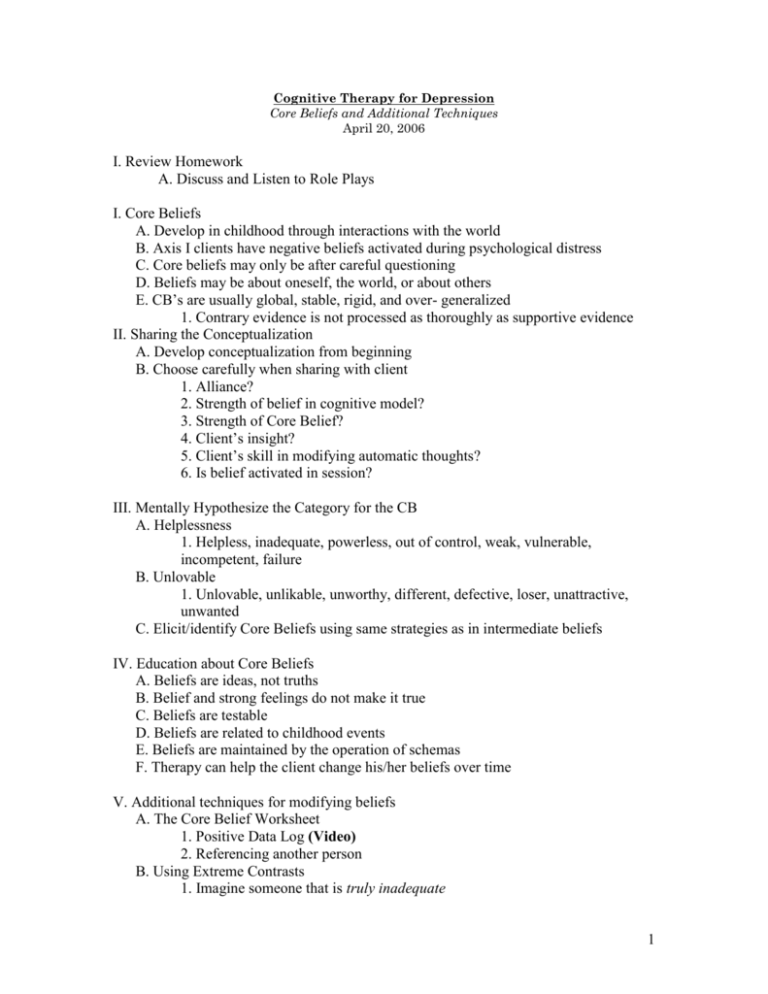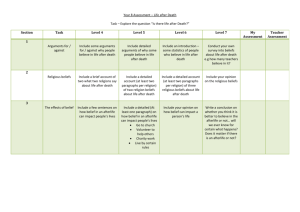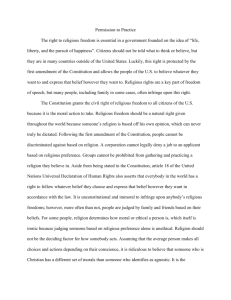Cognitive Therapy for Depression
advertisement

Cognitive Therapy for Depression Core Beliefs and Additional Techniques April 20, 2006 I. Review Homework A. Discuss and Listen to Role Plays I. Core Beliefs A. Develop in childhood through interactions with the world B. Axis I clients have negative beliefs activated during psychological distress C. Core beliefs may only be after careful questioning D. Beliefs may be about oneself, the world, or about others E. CB’s are usually global, stable, rigid, and over- generalized 1. Contrary evidence is not processed as thoroughly as supportive evidence II. Sharing the Conceptualization A. Develop conceptualization from beginning B. Choose carefully when sharing with client 1. Alliance? 2. Strength of belief in cognitive model? 3. Strength of Core Belief? 4. Client’s insight? 5. Client’s skill in modifying automatic thoughts? 6. Is belief activated in session? III. Mentally Hypothesize the Category for the CB A. Helplessness 1. Helpless, inadequate, powerless, out of control, weak, vulnerable, incompetent, failure B. Unlovable 1. Unlovable, unlikable, unworthy, different, defective, loser, unattractive, unwanted C. Elicit/identify Core Beliefs using same strategies as in intermediate beliefs IV. Education about Core Beliefs A. Beliefs are ideas, not truths B. Belief and strong feelings do not make it true C. Beliefs are testable D. Beliefs are related to childhood events E. Beliefs are maintained by the operation of schemas F. Therapy can help the client change his/her beliefs over time V. Additional techniques for modifying beliefs A. The Core Belief Worksheet 1. Positive Data Log (Video) 2. Referencing another person B. Using Extreme Contrasts 1. Imagine someone that is truly inadequate 1 2. Imagine someone that is truly a failure C. Using metaphors D. Testing CB Historically 1. Use Core Belief Worksheet to examine old beliefs E. Restructure Early Memories 1. Re-experience early event and heighten affect to elicit memory a. Role play and switch roles 2. Re-experience earlier event a. Heighten affect b. Talk to “younger” part of the patient c. Use Guided Imagery, role playing, Socratic questioning VI. Problem Solving A. Create a problem list 1. Encourage client to put problems on the agenda each week 2. Translate problems into positive goals a. Change “I don’t have any friends” b. To “I would like to increase my skills at meeting people” or “I would like to meet one new person this week.” 3. Problems may be small or involve major life changes VII. Decision Making A. List advantages and disadvantages 1. Use Socratic questioning to elicit both sides 2. Evaluate cognitive distortions that may be discovered 3. Encourage writing so there is “evidence” of the “pros and cons” 4. Evaluate the items based on importance VIII. Behavioral Experiments A. Identify “testable” negative hypothesis 1. “I can’t talk to people I don’t know.” 2. “If I ask for help, my professor will laugh at me.” 3. “I’ll never get an appointment with a psychiatrist.” B. Problem-solve around the behavioral test C. Discuss coping strategy for negative outcome IX. Activity Monitoring and Scheduling (Video) A. Use activity scheduling to increase activities that produce pleasure or a sense of accomplishment 1. Look for trouble spots (e.g. evenings, weekends) B. Use activity monitoring to gather information about their activities as well as trouble spots 1. Use Socratic questioning to evaluate the impact of their activities (or inactivity) during the week. C. Develop scale of activities based on pleasure and sense of accomplishment 1. Subtly challenging distortions around ratings if necessary 2 X. Additional Techniques A. Strategize activities or strategies the client can use to distract him/herself from anxiety or dysphoria 1. What activities or strategies work? 2. Does distraction get in the way of challenging thoughts? B. Relaxation techniques (see handout) C. Coping Cards 1. Adaptive Response 2. Coping Strategies 3. Instructions to Activate oneself D. Gradual Exposure E. Role Playing F. Pie Charts 1. Ideal versus actual activities or “emotional energy” 2. Contribution of various factors to negative outcome XI. Additional Techniques (cont.) A. Dysfunctional Self-Comparisons 1. Address negative attentional biases 2. Comparisons to others without a mental illness 3. Comparisons to pre-morbid functioning B. Positive Self-Statements 1. Encouraging client to attend to positive attributes/behaviors 3







